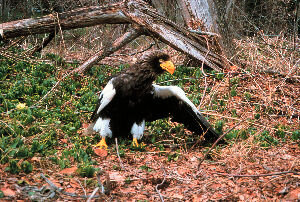Steller's Sea Eagle
Haliaeetus pelagicus
The Steller’s Sea Eagle is a relative of the bald eagle and breeds only on the eastern coast of Russia. It is one of the largest eagle species in the world, weighing between 14 - 19 pounds. Adults are characterized by large yellow beaks, and distinctive black and white plumage. Juveniles have dark beaks and brown mottled plumage.
Studies in Russia
Starting in 1993 the Institute became involved in conservation issues with Steller’s sea eagles in Russia. IWS staff and Dr. Michael McGrady traveled to city of Magadan on the eastern coast of Russia. There we met with our Russian colleagues from the Magadan State Reserve and went by boat to survey small islands and coastal areas in the Tauy Bay and on the Koni Peninsula for sea eagles. When nest sites were located we attempted to climb the trees or cliff nest sites to collect biological data on the eaglets. On the Kava and Chelomzhe Rivers east of Magadan we used ultralight aircraft to survey the rivers for nesting eagles. It was an excellent (and exciting!) method of both locating nests and determining the number of eaglets present in each nest. Of 28 territories visited, 18 were active and produced 1.16 chicks/nest. Subsequent efforts from 1993 through 1998 provided for coverage of 1,852 km of coastline and 1,154 km of rivers where a total of 274 nests were identified. In 2000, another trip to Russia was funded by The Trust for Mutual Understanding to place backpack-mounted telemetry transmitters on nestling Steller’s sea eagles to document their movements. It was also hoped that these transmitters would help in detecting the birds if they migrated to Hokkaido, Japan to spend the winter. The telemetry transmitters, donated by Communications Specialists, Inc., were designed to function for approximately four years thus allowing long-term follow-up of the birds. Three of the young eagles were detected in Hokkaido, Japan during the winter of 2000/2001, two of which were later found dead of lead poisoning (see Japan project summary for details). In August 2002 another trip was made to Russia by our colleagues in Japan to place additional transmitters on nestling eagles to provide a greater understanding of long range movements by yearling Steller’s sea eagles. Furthermore, we are seeking to better understand how these young sea eagles might be threatened by the lead poisoning problems discovered in Japan.
Studies in Japan
In 1993 IWS staff were invited to Japan to participate in discussions on the biology of Steller’s sea eagles and to help comment in public forums on the increased incidence of lead poisoning in wintering Steller’s sea eagles. Dr. Keisuke Saito, wildlife veterinarian at the Institute for Raptor Biomedicine Japan, presented us with data on the number of Steller’s and white-tailed sea eagles that had been recovered dead or dying from lead poisoning. Between 1994 and 2000, Dr. Saito and his colleagues encountered 72 of these eagles that were confirmed to have been poisoned by lead. Lead poisoning in bald eagles in North America has most commonly been associated with their consuming waterfowl containing lead shotgun pellets. In Japan, the problem arose from eagles feeding on hunter-killed Sika deer.
Sika deer
Because the historic food source of the wintering eagles, northern pollock, had sharply declined, the eagles began searching for alternative food sources. In Japan, the regulations do not require that hunters bring carcasses out of the field. Instead, the sportsmen remove the desired meat from the carcass and leave the remains. While in some respects this would be a windfall for the scavenging eagles, the remaining meat on the carcasses can contain fragments of the lead bullets used to kill the animal. Thus, some of these eagles later succumb to lead poisoning.
Sick sea eagle
X-ray of Steller's sea eagle with lead shot
Due in part to lectures and press conferences that IWS staff participated in, the Japanese legislature passed a law that required hunters to use lead-free rifle bullets starting in 2000. We and our colleagues in Japan, Russia, Europe and the United States that are working on Steller’s sea eagle conservation issues applauded the Japanese legislature for taking this progressive step to help conserve this eagle species. However, the law did not apply to the use of lead slugs in shotguns and we were still concerned with the potential for eagles to be poisoned. In the winter of 2000, three of the young eagles equipped with telemetry transmitters in Russia were located in Hokkaido. Unfortunately, two of the three birds were found dead from lead poisoning. When the news of these deaths reached the mass media in Japan, the Japanese government decided to ban the use of lead slugs in shotguns as well as the previously banned lead rifle bullets. Our contribution to tracking the movements and survival of the young Steller’s sea eagles lead directly to this significant change in Japanese law. We hope to continue to cooperate with Steller’s sea eagle conservation issues in Japan by assisting in the capture of birds to obtain blood samples, allowing assessment of lead and other contaminant levels in their bodies.






